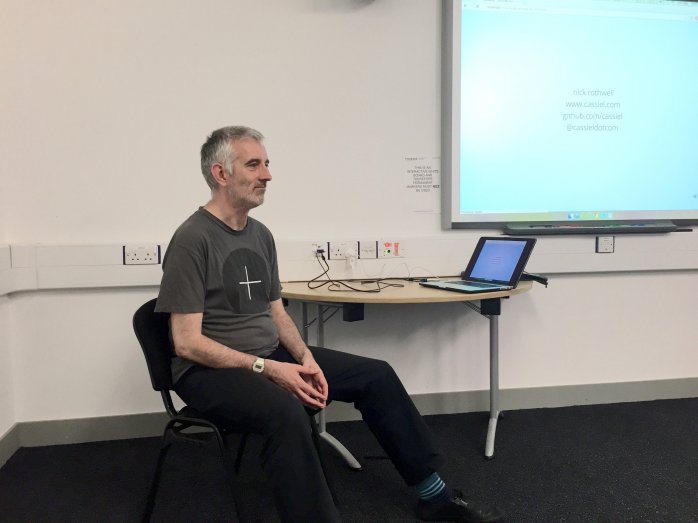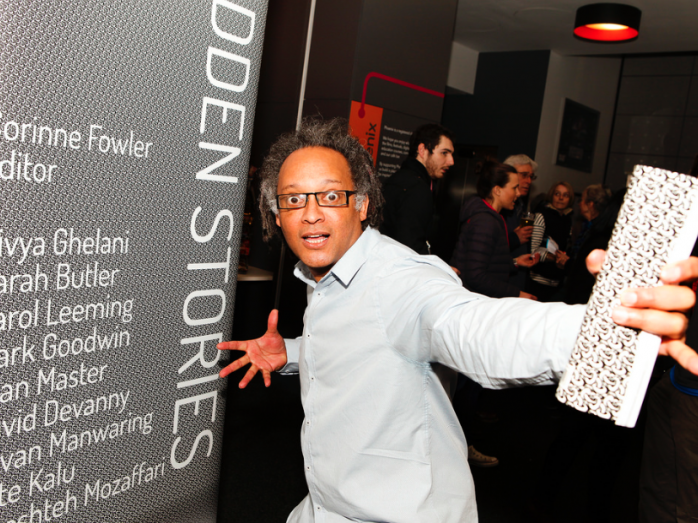Tags: Interact Labs
Luke Woodbury CAS Talk
Posted: Sat, 23 May 2015 16:04
Luke Woodbury gave a very interesting talk about his work on Wednesday. Despite being based in Bristol, Luke seems to have established himself quite well in Leicester - with involvement in local projects such as Pop Up Play and Esther Rolinson's exhibition at Phoenix last year.
He spoke about these projects, and others, during his presentation and answered many questions. A video recording of the talk is available here on Vimeo.
We will be having a break from hosting talks of the summer, but plan to return in the autumn. Keep an eye on the Interact Labs website for details.
Nick Rothwell CAS Talk
Posted: Thu, 16 Apr 2015 17:00
We had a very interesting talk from Nick Rothwell last night. Nick is a programer and sound artist who works extensively with choreographers and dancers. His 'performance systems' feature light, projections, music and he has a strong systems aesthetic in what he does. A recording of the talk is available here on Vimeo. Nick's website can be found at http://www.cassiel.com.
Affective Digital Histories
Posted: Tue, 07 Apr 2015 16:10
The Affective Digital Histories project has just come to an end following the launch of the Hidden Stories book at Phoenix on the 31st March. The project was exploring how "technology" can be used to connect people with the history of an area - in this case Leicester's St Georges area aka the Cultural Quarter.
Working with our Leicester University and Phoenix partners, Cuttlefish and Interact Labs developed two iPhone and Android apps - Hidden Stories and Sounds of the Cultural Quarter - as well as a new website and a "video booth" system.
The apps form part of our ongoing investigations in to "locative media" and allow people to explore creative writing and soundscapes that are located in the Cultural Quarter. You can use them as you walk around the area, or from a fixed location.
For more information about the apps (and how to download them for free) and the project in general visit the website at http://www.affectivedigitalhistories.org.uk.
Alex May CAS Talk, Crystal Radio Workshop
Posted: Sun, 15 Mar 2015 18:04
Interact Labs started its spring CAS speaker programme on Wednesday with a talk from artist Alex May. The 20+ audience was treated to an interesting talk from Alex about his creative practice that has included programming, VJing, projection mapping and robotics. We hope to upload a video of the talk soon, for now you can view pictures here. Alex's website can be found at www.alexmayarts.co.uk. Keep an eye our for details of April speaker, who we will be announcing shortly.
We also hosted our first workshop of the year on Saturday. Our "Make a Crystal Radio" workshop was scheduled to tie in with the Julian Oliver exhibition in the Phoenix Cube Gallery. The attendees were able to build a crystal radio from scratch and learnt a bit of radio theory along the way. Read a workshop report here. Again, keep an eye on the Interact Labs website for details of future workshops.
Creat-A-Con February 2015
Posted: Sat, 21 Feb 2015 19:46
Creat-A-Con was a one-day Creative Technology organised by Jason Boomer of SideFest. It took place in the Queens Building at DMU in Leicester on the 21st February 2015. Exhibitors included Leicester Hackspace, Creative Manifesto, Starbase Leicester and Interact Labs. Over 500 people attended the event.
Interact and Interact Labs brought a range of art and technology exhibits along for people to play with.
Our Robot Arm always goes down well, and was joined at this event by a new Edison Mini Robot. This is a great little learning 'bot that is also great value for money.
Our WaterColourBot suffered a little in transport and was not performing at its best, but people still liked it. The 3D Printer also suffered a little, but was eventually set-up to produce a steady stream of whistles for people (mostly children) to take away. For many attendees it was the first time that they had seen a 3D printer in action.
We brought some DIY Virtual Reality headsets along too. However, we also had the Oculus Rift on loan to Starbase and in the end settled on encouraging people have a go with that instead. Reports were that the queue didn't die down all day.
Finally, we seem to have found a new star - the Arduino-powered Jamm Jar computer. This is a new project by Sean Clark that features a neoPixel LED ring, Arduino micro-controller, switch and rechargeable battery, all placed in a glass jam jar (see some pictures here). He has been using this device in workshops and is looking to develop it further as part of a new series of artworks. Attendees seemed to be fascinated by them and enjoyed the LED lighting patterns it produced.
Despite the odd technical problem, it was a great day. SideFest brought a very impressive audience to the event and the DMU student volunteers (and the non-DMU ones too) were incredibly helpful. We're already looking forward to the next one!
See our pictures from the event here on Flickr.
Creat-A-Con is Almost Here!
Posted: Mon, 09 Feb 2015 12:22
Creat-A-Con will be coming to Leicester on the 21st February at the Queens Building at De Montfort University. This free event aims to inspire young people in the key S.T.E.M. areas of Science, Technology, Engineering, and Mathematics.
Interact Labs will be at the event demonstrating:
- The Edison robot and our robot arm
- The WaterColourBot drawing machine
- Scratch programming on the Raspberry Pi
- Our 3D printer
- DIY Virtual Reality headsets
Plus we will be making Arduino-powered interactive lights for use at the MyOptik Festival on the 28th February and testing the wireless video system we are making for the Image is the Servent event on the 27th February.
As if that isn't enough, we will also be showing the Creative Manifesto LED video wall.
Come and be creative with digital technology.
3D Printing / Arduino Projects
Posted: Fri, 23 Jan 2015 21:07
We have a couple of interesting 3D Printing / Arduino projects in the Lab at the moment. Both are being undertaken by final-year DMU Music Technology students and involve the construction of music input devices.
Luke Petterson's project involves modifying a MIDI keyboard to feature transparent keys with coloured LEDs within them to provide a learning and performance tool. The challenges of this project include 3D printing the transparent keys for the keyboard and developing Arduino technology to control the LEDs in the keys.
Evan Campbell is creating a MIDI controller that will contain distance sensors and a switch pad. The distance sensors will allow the musician to be expressive and the switch pad will be used to create a drum sequencer. Again the project makes use of an Arduino, with 3D printing used to create the housing.
Both project are moving ahead nicely. There will be a chance to look at both projects in detail next month at the Creat-A-Con event on the 21st February and in the next Open Lab on the 24th February.
3D Printer Experiments
Posted: Wed, 14 Jan 2015 16:20
One of the great things about the "fused filament" 3D printer we use in the Lab at Phoenix is that you can use it to experiment with different printing materials. It's had wood-based filament run through it recently, as well as flexible BendLay, ColorFabb copperFill and water-soluble PVA.
These newer filaments allow for some quite interesting print effects and let make things that don't initially look as if they have been 3D printed. The copperFill looks particularly impressive once you have sanded-down the model. The PVA has a different use though. On a dual-head printer you can use it to make dissolvable support structures.
Support structures are needed whenever you are trying to print something with overhangs. They consist of thin 'towers' of plastic that hold up the parts of your print that would otherwise sag or collapse if you didn't use them. Support is designed to be removed easily, but this process can take a while and may leave ugly marks on your print.
Enter the idea of using PVA for support. Polyvinyl Alcohol is a polymer that can be turned in to a filament that will run through a 3D printer at a similar temperature to common PLA. When used as a support material for PLA prints it does the job of supporting overhangs during the print but when the printing process is complete there is no need to remove it manually. Instead, you simply pop your model in a bowl of water for a few hours and the PVA support simply dissolves away.
It look us a few attempts to get the process to work but once we got the temperature right the process works pretty reliability. During the build we found that the models can look very messy - the picture attached shows a model that has a mixture of white PVA supports and a red PLA body - but once they have been left in water overnight they look fine.
We obtained our PVA filament from the iMakr shop in London. You'll also find it on eBay.
Affective Digital Histories Apps
Posted: Thu, 27 Nov 2014 21:25
The public launch of Affective Digital Histories took place at LCB Depot in Leicester's Cultural Quarter on Thursday 27 November 2014.
The event was well attended and attracted local media attention. Throughout the evening there were talks by project members; the first showing of a short film about the project; a live performance by award winning Leicester poet and playwright Carol Leeming; and opportunities to download and try two new apps - Hidden Stories and Sounds of the Cultural Quarter - that have been developed as part of the Affective Digital Histories project.
Feedback from attendees was very positive and there have been over 100 downloads of the apps already. Visit the Affective Digital Histories apps page to find links to both the iPhone and Android versions.
Creative Manifesto LED Video Wall
Posted: Mon, 17 Nov 2014 18:51
If you've visited the Lab over the past few months you will have noticed that its been somewhat 'busy'. The set-up for the Interact exhibition at LCB Depot in September was based there, same for Esther Rolinson's exhibition at Phoenix, the Affective Digital Histories video booth was there for a while and, most noticeably, Creative Manifesto have been using it to build their LED video screen.
Watching the Creative Manifesto project take shape has been fascinating. The group was successful in getting Arts Council funding to design and build a 24 panel video screen that could be use to showcase local artists' work. The screen was constructed using LED 'pixel strings', Fadecandy controllers and some cleverly modified plastic greenhouse panels. Members of Creative Manifesto have been using Interact Labs to make the screen - and also tapping in to our electronics and programming expertise.
The first outing of the screen was on Sunday night as part of the Light The Night festival in Leicester's Cultural Quarter. It was installed in the window of the Exchange Bar and looked amazing. The public was clearly impressed, with large crowds watching the animations on screen and taking photographs.
The screen will be installed at Exchange for a week or so, so there is plenty of time to go and have a look in the evenings. Pictures from the Light The Night event can be found here on Flickr. There is a video of the screen here on YouTube.
We will be publishing full construction details for the project on this website soon.
























